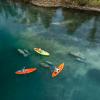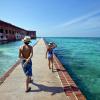By Steve Winston
On Dec. 5, 1945, four months after the end of World War II, five “Avenger” torpedo bombers took off from the Naval Air Station Fort Lauderdale. Referred to now as "Bermuda Triangle Flight 19," they were headed east for the Bahamas to practice bombing runs on a sunken ship. The five planes – and their 14 crew members – never returned.
After they radioed a distress call to the base, a PBM-Mariner “Flying Boat” search plane was sent out to look for Flight 19. That plane – and its 13 crew members – never came back, either.
There was no “hostile action;” the war was over. There were no reports of large storms over the ocean. There were no reports of any crashes in the area. And no wreckage ever found. Six planes, and 27 crew members, simply disappeared.
Some have blamed “The Bermuda Triangle,” that mysterious watery graveyard in which countless ships and planes have been lost. Although a few World War II planes have been found in the area, none has ever been positively identified as being from Flight 19, or as the rescue plane.
As the years went by, and the legends piled up, Flight 19 became known as “The Lost Patrol.”
Today, in an old, ramshackle barracks building on the periphery of Fort Lauderdale-Hollywood International Airport – the only original structure still remaining on the site of the Naval Air Station – the Lost Patrol is memorialized in this historical Florida site.
Inside this old museum, maintained and managed by the Naval Air Station Fort Lauderdale Historical Association, it’s 1944 again. The world is at war. And the uniforms, training equipment, posters, machines, flags, teletypes, mock training aircraft and medals of those days are on display, along with built-to-scale models of planes and ships, larger-than-life paintings, flight record – and the “George Bush Room,” a reproduction of the barracks room used by future-President George H. W. Bush when he trained here as an 18-year-old “Avenger” pilot before shipping out to the Pacific.
Here, every Dec. 5, surviving veterans who served at Naval Air Station Fort Lauderdale, along with friends and families, gather for a ceremony memorializing the crewmen of Bermuda Triangle Flight 19, the crewmen of the “Flying Boat” that searched for them and the 68 other flyers from this base who died in WWII.
Before the war, this was empty land. By 1943, however, more than 2,500 men (and women) were based here, including not only pilots, but also machinists, communications specialists, gunners, and weapons specialists. And they weren’t only Americans; a number of Britons trained here, as well.
On that fateful morning of Dec. 5, the weather was described by the base water specialists as “Favorable… sea state moderate to rough.” Ninety minutes after the five Avengers of Flight 19 took off toward the Bahamas, when the tower at the Naval Air Station had been expecting to hear a request for landing instructions, they were surprised to hear Mission Commander Charles Taylor radio that he was lost.
“Cannot see land,” Taylor said. “We seem to be off-course.”
“What is your position?” the tower at the Naval Air Station responded. There were several moments of silence.
“We cannot be sure where we are,” Taylor said. “Repeat: Cannot see land.”
Contact was lost for the next ten minutes. Then the tower received another transmission from Taylor’s Avenger. But it wasn’t from Taylor; it was from one of the crew.
“We can’t find West. Everything is wrong. We can’t be sure of any direction. Everything looks strange… even the ocean.”
Then there was another delay, after which a voice bordering on hysteria (not Taylor’s) radioed the tower.
“We can’t tell where we are… everything is… can’t make out anything. We think we may be about 225 miles northeast of base…”
That pilot rambled on nervously for a few minutes and then uttered the last words ever heard from Flight 19.
“It looks like we are entering white water… We’re completely lost.”
Then… silence.
For the next several days, hundreds of aircraft and ships combed the waters searching for survivors, or wreckage. But nothing was ever found.
Ever since, researchers have been trying to figure out what happened to the five planes of Flight 19, and to the “Flying Boat” aircraft that went searching for them.
In addition to the Bermuda Triangle theory, a number of other theories have been bandied about. But most experts believe that Flight 19 simply went off course – northward to the open sea rather than eastward toward the Bahamas – and then each plane ran out of gas and had to ditch. But that theory still doesn’t explain the disappearance of the rescue plane.
Today, a local doctor named John Bloom and his wife, Minerva, volunteer at the museum, along with Debbie McIlhenny, daughter of the museum’s founder, a World War II sailor named John McIlhenny. In this small old barracks from another time, they lovingly care for one of the finest collections of World War II items in America.
But, like everyone else who’s tried to figure it out, they can’t answer the question for sure, either.
What, exactly, happened to the Lost Patrol? And what happened to the rescue aircraft sent out to search for them?
Was it entirely-logical circumstance? Or was it the Bermuda Triangle?
When you go…
The Naval Air Station Fort Lauderdale Museum
4000 West Perimeter Rd.
Fort Lauderdale, FL 33315
(754) 300-9259 or (954) 359-4400
Call ahead to reserve a tour.
Admission is free, but donations are appreciated.



























